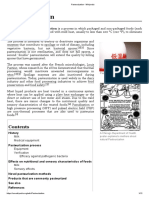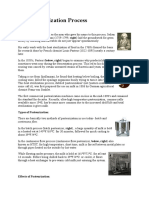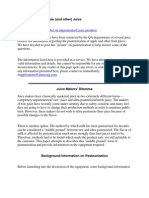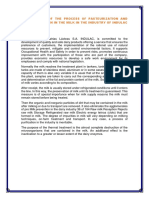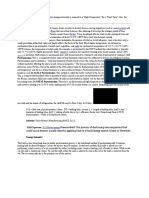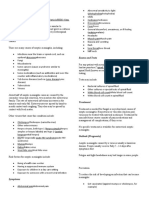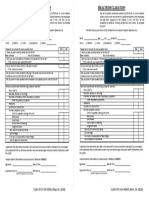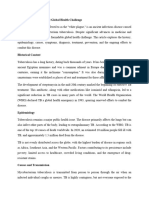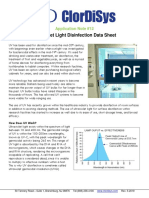A Mini Review On Technique of Milk Pasteurization: Simran Watts
A Mini Review On Technique of Milk Pasteurization: Simran Watts
Uploaded by
Azzhna pCopyright:
Available Formats
A Mini Review On Technique of Milk Pasteurization: Simran Watts
A Mini Review On Technique of Milk Pasteurization: Simran Watts
Uploaded by
Azzhna pOriginal Title
Copyright
Available Formats
Share this document
Did you find this document useful?
Is this content inappropriate?
Copyright:
Available Formats
A Mini Review On Technique of Milk Pasteurization: Simran Watts
A Mini Review On Technique of Milk Pasteurization: Simran Watts
Uploaded by
Azzhna pCopyright:
Available Formats
Journal of Pharmacognosy and Phytochemistry 2016; 5(5): 99-101
E-ISSN: 2278-4136
P-ISSN: 2349-8234
JPP 2016; 5(5): 99-101 A mini review on technique of milk pasteurization
Received: 15-07-2016
Accepted: 16-08-016
Simran Watts
Simran Watts
Department of Biotechnology, Abstract
Mahatma Jyoti Rao Phoole
The process of pasteurization was debated in the House of Commons and the suggestion made that no
University, Jaipur, India.
raw milk should be sold for human consumption. This would mean installation of expensive machinery
by every supplier, and if it should become compulsory there is little doubt that many small firms would
shut down and the business pass in the hands of a few big dealers.
If we are to be compelled to drink pasteurized milk, we should at least understand what pasteurization
means. It set out to accomplish two things: Destruction of certain disease carrying germs and the
prevention of souring milk. These results are obtained by keeping the milk at a temperature of 145
degrees to 150 degrees F. for half an hour, at least, and then reducing the temperature to not more than 55
degrees F. Pasteurization can be done as a batch or a continuous process. A vat pasteurizer consists of a
temperature controlled, closed vat. Milk bacteria like acid producers, Gas producers, ropy or stingy
fermentation, proteolytic and lipolytic bacteria which are killed by process of pasteurization.
Keywords: Milk, pasteurization. pasteurization temperature, Bacillus, Coliforms
Introduction
A process named after scientist Louis Pasteur which uses the application of heat to destroy
human pathogens in foods. For the dairy industry, the terms "pasteurization", "pasteurized"
and similar terms shall mean the process of heating every particle of milk or milk product, in
properly designed and operated equipment, at a specific temperature and held continuously at
or above that temperature for at least the corresponding specified time [1].
Pasteurization is the process of heating every particle of milk or milk product. Pasteurization
involves heating food to a temperature that kills disease-causing microorganisms and
substantially reduces the levels of spoilage organisms. Pasteurization or pasteurisation kills
microbes (mainly bacteria) in food and drink, such as milk, juice, canned food, and others. It
was invented by French scientist Louis Pasteur during the nineteenth century. Unlike
sterilization, pasteurization is not intended to kill all microorganisms in the food. Instead, it
aims to reduce the number of viable pathogens so they are unlikely to cause disease (assuming
the pasteurized product is stored as indicated and is consumed before its expiration date).
Commercial-scale sterilization of food is not common because it adversely affects the taste and
quality of the product.
Significant events in the development of Milk Pasteurization
1765 the Italian naturalist, Spallanzani, noted that boiling preserves meat extracts.
1782 the Swedish chemist, Scheele, preserved vinegar by boiling
1810 Appert used heat treatment to preserve foods (closed container).
1861 the "germ theory" was developed
1864 Pasteur reported that heat application to wine and beer prevents acid, bitter and ropy
defects in wine. (This process was termed "pasteurization".)
1867 Pasteur applies heat to milk and reports the process postponed milk souring.
1886 the heating of milk (boiled in a bottle) for infant feeding reduced illness and saved lives
by eliminating pathogens was advocated by Soxhlet (Germany), Jacobi (U.S.).
1893 Straus set up facility to pasteurize milk for infants. The first medical commission was
formed to oversee the production of “certified milk”.
1920's “Endicott studies” occurred in Endicott, NY by dr’s north and pack developing
Correspondence temperature destruction curves relative to mycobacterium and tuberculosis
Simran Watts 1924 the Usphs created "the office of milk investigations" under the strong leadership of Leslie
Department of Biotechnology, Carl frank.
Mahatma Jyoti Rao Phoole 1924 the state of Alabama worked closely with the Usphs to develop the first federal milk
University, Jaipur, India.
ordinance patterned after "the Alabama standard milk grading ordinance."
~ 99 ~
Journal of Pharmacognosy and Phytochemistry
1941 Pyrex heat-resistant glass piping used in dairy industry known as the “dairy initiatives”. Emphasis placed on in-depth
as a means of conserving critical materials during wartime. FDA and state ratings involving down- time equipment
1952 several states met in St. Louis to discuss the problems of inspections, product sampling, and tracing product flows to
reciprocity for shipping milk across state lines. This was the evaluate possible cross connections.
first national conference on interstate milk shipments. Also 1986 Listeria outbreaks in California fuels further
much recognition to Dr. C.A. Abele and Dr. Everett investigations on post pasteurization contamination problems
wallenfeldt for their early pioneering efforts in the in cheese and milk plants. Computer controls accepted for
development of the grade a milk program. milk pasteurization systems
1953 the first 3-a standard for CIP cleaning was published. 1994 salmonella outbreak traced to ice cream. Probable
1955 the first automated CIP system installed in an Ohio milk etiology was hauling of raw liquid eggs in milk tanker which
plant. was used to subsequently haul pasteurized mix. Freezing and
1956 minimum temperature for vat pasteurization was raised packaging was done without re-pasteurizing the mix. Large
from 142 of to 145 of based on heat resistance of coxiella numbers of culture confirmed cases.
burnetii. Based on university of california-davis studies in late 1994 contaminated water in a plant was suspected cause of
1940's 1966 FDA memorandum accepts dual stem (CIP) flow packaged milk transmitting E. coli to consumers in Montana.
diversion device to be used in htst systems. Failure of well disinfectant led to subsequent contamination
1978 first u.s. uht “sterile” milk system commissioned in of pasteurized milk storage tank culture confirmed cases plant
Georgia. closed [2]
1979 magnetic flow meter systems found acceptable for use
as replacement for conventional timing pumps. Types of pasteurization
1985 major salmonellosis outbreak in Chicago spawned
increased emphasis on milk processing sanitation, became
Table 1: Types of milk pasteurization Process of pasteurization of milk [4]
There are four common types of milk pasteurization that vary • Vat Pasteurization
with temperature and time the milk is held at that temperature • High Temperature/Short Time (HTST)
[5]
. • Ultra-pasteurization (UP)
• Ultra-High-Temperature (UHT)
Fig 1: Milk Pasteurization Technique [6]
~ 100 ~
Journal of Pharmacognosy and Phytochemistry
Micro-organisms killed by pasteurization
Acid producers- Streptococci, Lactobacilli, Microbacteria,
Coliforms, Micrococci Gas producers- Coliforms, Clostridium
butyricum, Torula cremoris Ropy or stringy fermentation-
Alcaligenes viscolactis, Enterobacter aerogenes Proteolytic
organisms- Bacillus spp., Pseudomonas spp., Proteus spp.,
Streptococcus liquefaciens Lipolytic organisms-
Pseudomonas fluorescens, Achromobactor lipolyticum,
Candida lipolytica, Penicillium spp [7]
Conclusion
Pasteurization certainly has its place. But it's widespread use
to process most of the foods we consume, simply to improve
the bottom line of large corporations (by allowing for long-
term warehousing and long-distance shipping of foods, and
skimping of proper cleanliness practices), is not only not
necessary but harmful to our health.
It is undoubtedly beneficial to destroy dangerous germs, but
pasteurization does more than this it kills off harmless and
useful germs alike, and by subjecting the milk to high
temperatures, destroys some nutritious constituents.
References
1. Microbiology Press cott, fifth edition.
2. Lance Day, Ian McNeil. Biographical Dictionary of the
History of Technology. Routledge. ISBN 0415193990. 7.
Gordon L. 1996.
3. Food safety of raw milk. Foodsmart. Govt. nz. Retrieved
20140319.
4. Wilson GS. The Pasteurization of Milk, British Medical
Journal. 1943; 1(4286):261. doi:10.1136/bmj.1.4286.261,
PMC 2282302, PMID 20784713
5. Wikipedia, free encyclopedia.pdf.
6. www.realmilk.com/
7. Oliver SP, Jayarao BM, Almedia RA. Food borne
pathogens in milk and the dairy environment food safety
and public health implications. Food borne Pathogens and
Diseases. 2005; 2:115-1129. [DOI via Crossref]
[Pubmed].
~ 101 ~
You might also like
- Wesnbhie45oz5jsb0nv5amut PDFDocument4 pagesWesnbhie45oz5jsb0nv5amut PDFKabir Dhankhar0% (4)
- d9152 PDFDocument11 pagesd9152 PDFAnuja AnushaNo ratings yet
- Commentary: History, Trends, and Extent of PasteurizationDocument4 pagesCommentary: History, Trends, and Extent of Pasteurizationhai leNo ratings yet
- 5pasteurization - WikipediaDocument12 pages5pasteurization - WikipediaCactusToastNo ratings yet
- Pasteurization: Pasteurization or Pasteurisation Is A Process in Which PackagedDocument13 pagesPasteurization: Pasteurization or Pasteurisation Is A Process in Which Packagedjovmac2uNo ratings yet
- Pasteurization: HistoryDocument5 pagesPasteurization: HistoryAna LaurNo ratings yet
- Pasteurized VsDocument55 pagesPasteurized VsMuhammad Munirul AlamNo ratings yet
- Pasteurization of MilkDocument18 pagesPasteurization of MilkSangeethaNo ratings yet
- Abaton FPT013Document8 pagesAbaton FPT013Jhalaynie AbdulrahimNo ratings yet
- Food Preservation - Pasteurization 13.02.17Document13 pagesFood Preservation - Pasteurization 13.02.17Shania Moesha AlexanderNo ratings yet
- Milk Pasteurization and Equipment: April 2019Document31 pagesMilk Pasteurization and Equipment: April 2019LoredanaNo ratings yet
- PASTEURIZATIONDocument14 pagesPASTEURIZATIONMarina LoveranesNo ratings yet
- Raw Milk FinalDocument32 pagesRaw Milk FinalnophadonNo ratings yet
- Giribaldi 2016Document6 pagesGiribaldi 2016Alejandro NuñezNo ratings yet
- 1 s2.0 S0362028X23008578 MainDocument14 pages1 s2.0 S0362028X23008578 Maintrancongdoan2003No ratings yet
- Food Preservation: Heat and Cold TreatmentsDocument13 pagesFood Preservation: Heat and Cold TreatmentsRuchi JainNo ratings yet
- Milk Processing OperationDocument93 pagesMilk Processing OperationMohit AgarwalNo ratings yet
- Developments: Food Technology Is A Branch ofDocument2 pagesDevelopments: Food Technology Is A Branch ofMonika KshetriNo ratings yet
- Article 26Document9 pagesArticle 26palsantanu8837276365No ratings yet
- Milk Quality and Safety FinalDocument18 pagesMilk Quality and Safety FinalPanda HoughNo ratings yet
- Pasturization, Sterilizationo and FermentationDocument36 pagesPasturization, Sterilizationo and Fermentationkwagala joshuaNo ratings yet
- 3.FinalRecentTechnologiesinDairysci Finalbook 17 5 20192 67 94Document29 pages3.FinalRecentTechnologiesinDairysci Finalbook 17 5 20192 67 94sudhineeharindhanavudhiNo ratings yet
- PasteurizationDocument14 pagesPasteurizationNaharia RangirisNo ratings yet
- The Pasteurization ProcessDocument20 pagesThe Pasteurization ProcessmarutimhNo ratings yet
- Pasteurization of AppleDocument8 pagesPasteurization of AppleNupur NagavekarNo ratings yet
- Project Report Prag by JagjeetDocument62 pagesProject Report Prag by JagjeetManoj ChaurasiyaNo ratings yet
- Food Safety 2Document5 pagesFood Safety 2api-3709624No ratings yet
- 3.1. Pasteurisation: 3. Beer Pasteurisation and Sterile Filtration and FillingDocument11 pages3.1. Pasteurisation: 3. Beer Pasteurisation and Sterile Filtration and Fillinggirum atnafuNo ratings yet
- Entrepreneurial Finance A Global Perspective Gary Gibbons & Robert D. Hisrich & Carlos M. DaSilva 2024 Scribd DownloadDocument34 pagesEntrepreneurial Finance A Global Perspective Gary Gibbons & Robert D. Hisrich & Carlos M. DaSilva 2024 Scribd Downloadlumieonissi100% (1)
- BiologyDocument2 pagesBiologySajeena NazeeraNo ratings yet
- EU Cheese Safety ReportDocument59 pagesEU Cheese Safety ReportOsman AitaNo ratings yet
- Pasteurization Good or Bad.: Submitted To: Submitted byDocument10 pagesPasteurization Good or Bad.: Submitted To: Submitted byAnurag PatelNo ratings yet
- Jeas 0815 2395Document6 pagesJeas 0815 2395Aishwarya KarangaleNo ratings yet
- Milk PasteurizationDocument13 pagesMilk PasteurizationSofian NurjamalNo ratings yet
- Lesson 06 What Is Pasteurization - Definition & Common Uses PDFDocument3 pagesLesson 06 What Is Pasteurization - Definition & Common Uses PDFGwendolyn CalatravaNo ratings yet
- Introduction To Milk ProcessingDocument8 pagesIntroduction To Milk ProcessingMintesnot Bogale100% (2)
- Wilbey2014.pdf Tratamiento Térmico de Alimentos, Principios de La PasteruizaciónDocument6 pagesWilbey2014.pdf Tratamiento Térmico de Alimentos, Principios de La PasteruizaciónJosabet UuhNo ratings yet
- Early History of Food TechnologyDocument1 pageEarly History of Food Technologyapi-237428586No ratings yet
- 9780875530024ch05-Patog en lecheDocument50 pages9780875530024ch05-Patog en lechelula.azanzaNo ratings yet
- Milk HygieneDocument37 pagesMilk HygienetesfayegujiNo ratings yet
- Resumen: Porcentaje de Reducción de Aerobios Mesófilos de La Leche Cruda Luego de La PasteurizaciónDocument3 pagesResumen: Porcentaje de Reducción de Aerobios Mesófilos de La Leche Cruda Luego de La PasteurizaciónKaty VásconezNo ratings yet
- Milk NoteDocument27 pagesMilk NoteMegha DebnathNo ratings yet
- Effect of Cold Chain Interruptions On The Shelf-Life of Fluid Pasteurised Skim Milk at The Consumer StageDocument9 pagesEffect of Cold Chain Interruptions On The Shelf-Life of Fluid Pasteurised Skim Milk at The Consumer Stageth laNo ratings yet
- Lecture 02 Milk Processing & PasteurizationDocument26 pagesLecture 02 Milk Processing & PasteurizationAli hamza SandhuNo ratings yet
- Keeping A Family Cow: CH 2 - What Makes Cows So Important?Document18 pagesKeeping A Family Cow: CH 2 - What Makes Cows So Important?Chelsea Green PublishingNo ratings yet
- Raw MilkDocument9 pagesRaw MilkJessicaDanae7No ratings yet
- PRESENCIA DE Listeria Monocytogenes EN LECHE CRUDA Y Quesos Frescos ArtesanalesDocument31 pagesPRESENCIA DE Listeria Monocytogenes EN LECHE CRUDA Y Quesos Frescos Artesanalesjuan carlosNo ratings yet
- PasteurizationDocument3 pagesPasteurizationGaus MohiuddinNo ratings yet
- Modeling and Controlling of Milk Fermentation Process Thesis - 2Document50 pagesModeling and Controlling of Milk Fermentation Process Thesis - 2ajithNo ratings yet
- Tra Ducci OnDocument22 pagesTra Ducci OnBellaNo ratings yet
- Condensed MilkDocument14 pagesCondensed MilkJon Mark100% (1)
- Milk and Cheese TestsDocument8 pagesMilk and Cheese TestsHemant VermaNo ratings yet
- foods-13-00451Document11 pagesfoods-13-00451Hải ĐứcNo ratings yet
- LWT - Food Science and Technology 116 (2019) 108476Document8 pagesLWT - Food Science and Technology 116 (2019) 108476Đức TrầnNo ratings yet
- Experiment 1 - Cheese MakingDocument6 pagesExperiment 1 - Cheese MakingCha CanceranNo ratings yet
- Pasteurised Milk: Process Flow DiagramDocument3 pagesPasteurised Milk: Process Flow Diagramedson eugenioNo ratings yet
- Effect of Pasteurization On The Bactericidal Capacity of Human MilkDocument8 pagesEffect of Pasteurization On The Bactericidal Capacity of Human Milkeswari ayyaswamyNo ratings yet
- HTST PasteurizationDocument1 pageHTST PasteurizationkaiserdarkNo ratings yet
- Heat ExchangersDocument18 pagesHeat ExchangersRofi AnwarNo ratings yet
- The Bacillus of Long Life a manual of the preparation and souring of milk for dietary purposes, together with and historical account of the use of fermenteFrom EverandThe Bacillus of Long Life a manual of the preparation and souring of milk for dietary purposes, together with and historical account of the use of fermenteNo ratings yet
- The Mysterious Cases of Martin Hewitt: 25 Mysteries & Detective StoriesFrom EverandThe Mysterious Cases of Martin Hewitt: 25 Mysteries & Detective StoriesNo ratings yet
- Phyllosticta Leaf SpotDocument3 pagesPhyllosticta Leaf Spotapi-233056161No ratings yet
- Candida Ciferrii, A New Fluconazole-Resistant YeastDocument2 pagesCandida Ciferrii, A New Fluconazole-Resistant YeastAndu1991No ratings yet
- Aseptic Meningitis: Exams and TestsDocument8 pagesAseptic Meningitis: Exams and TestsJoylyn Sagon VergaraNo ratings yet
- Lesson 1 Introduction To Bacteriology History Taxonomy and Bacterial Structure ModuleDocument16 pagesLesson 1 Introduction To Bacteriology History Taxonomy and Bacterial Structure ModuleTinNo ratings yet
- MT 6322 - Mycology and Virology 2nd Shifting OLADocument9 pagesMT 6322 - Mycology and Virology 2nd Shifting OLAlily bluesNo ratings yet
- Health: Quarter 3 - Module 7: Nature of Emerging and Re-Emerging DiseaseDocument15 pagesHealth: Quarter 3 - Module 7: Nature of Emerging and Re-Emerging DiseaseAlexes Alyza CañeteNo ratings yet
- Penicillin WSDocument2 pagesPenicillin WSAntonia HerambNo ratings yet
- Parasitology SAQs With AnswersDocument14 pagesParasitology SAQs With AnswersGeorge Makori100% (1)
- Form Blood RequisitionDocument2 pagesForm Blood Requisitionshubham kumar ram100% (1)
- VirusesDocument33 pagesVirusesShermaine GenistonNo ratings yet
- EUCAST Definitions of Clinical Breakpoints and ECOFFsDocument1 pageEUCAST Definitions of Clinical Breakpoints and ECOFFsMarcelo UGNo ratings yet
- LegionellaDocument40 pagesLegionellaniluh suwasantiNo ratings yet
- Iit Ashram: Class - Xii Gseb AssignmentDocument3 pagesIit Ashram: Class - Xii Gseb AssignmentChetanNo ratings yet
- Kelompok 4 - Review Jurnal - Identifikasi Bacillus CereusDocument13 pagesKelompok 4 - Review Jurnal - Identifikasi Bacillus CereusRIFQI FAYYADH ANSARNo ratings yet
- Stool Specimen CollectionDocument8 pagesStool Specimen CollectionPraveen KumarNo ratings yet
- 2021 12 14 21267769v1 FullDocument13 pages2021 12 14 21267769v1 Fullwatcher19890509No ratings yet
- C1 ESL Worksheet - Tropical Diseases in MedicineDocument3 pagesC1 ESL Worksheet - Tropical Diseases in MedicineKaty DianaNo ratings yet
- Exercise 1 - Bacterial ConjugationDocument5 pagesExercise 1 - Bacterial ConjugationLuke Jovanni TAOCNo ratings yet
- Health Declaration FormDocument1 pageHealth Declaration FormMc Arem PaghunasanNo ratings yet
- Myco Viro Mod 5Document3 pagesMyco Viro Mod 5Pauline Louise S. DURANNo ratings yet
- Jurnal BungaDocument3 pagesJurnal BungaKastaNo ratings yet
- SOP Stool Rectal Swab For Culture and SusceptibilitiesDocument8 pagesSOP Stool Rectal Swab For Culture and SusceptibilitiesRiad Al-GhorbaniNo ratings yet
- COVID 19 ReportDocument21 pagesCOVID 19 ReportDatu Nor Balindong82% (11)
- TuberculosisDocument4 pagesTuberculosisHadish BekuretsionNo ratings yet
- Emerging and Re Emerging DiseasesDocument49 pagesEmerging and Re Emerging DiseasesteklayNo ratings yet
- Plasmodium Vivax: Laboratory Diagnosis of MalariaDocument4 pagesPlasmodium Vivax: Laboratory Diagnosis of MalariaShaiji ShahidNo ratings yet
- UV Data SheetDocument15 pagesUV Data SheetBrian ThompsonNo ratings yet
- 15 Impressive Herbs With Antiviral ActivityDocument6 pages15 Impressive Herbs With Antiviral ActivityerinaNo ratings yet
- Radioloy 2Document25 pagesRadioloy 2Asif NewazNo ratings yet



